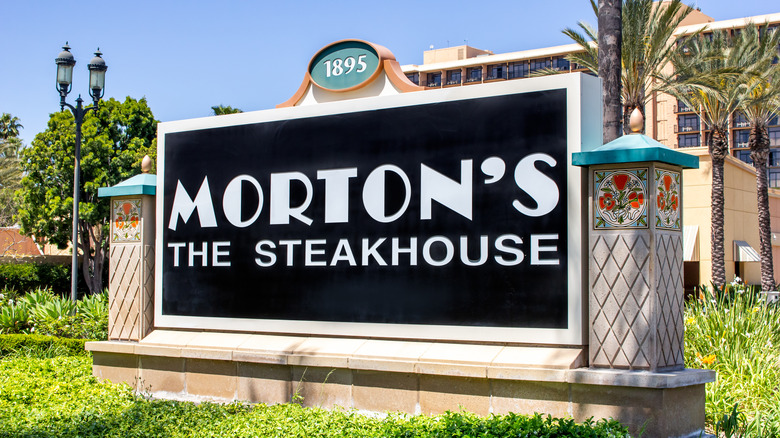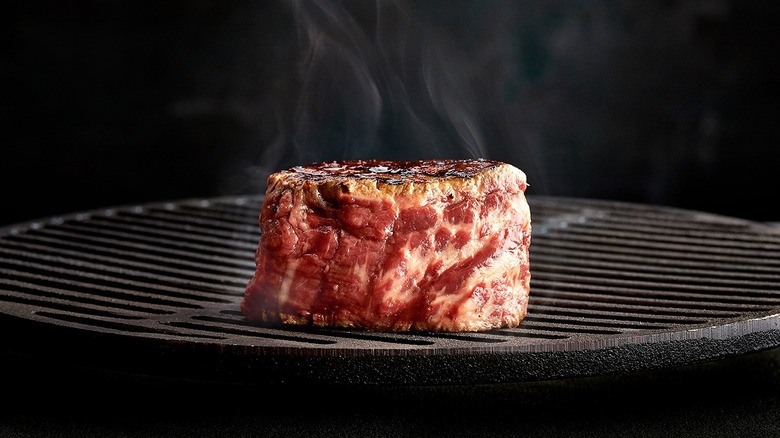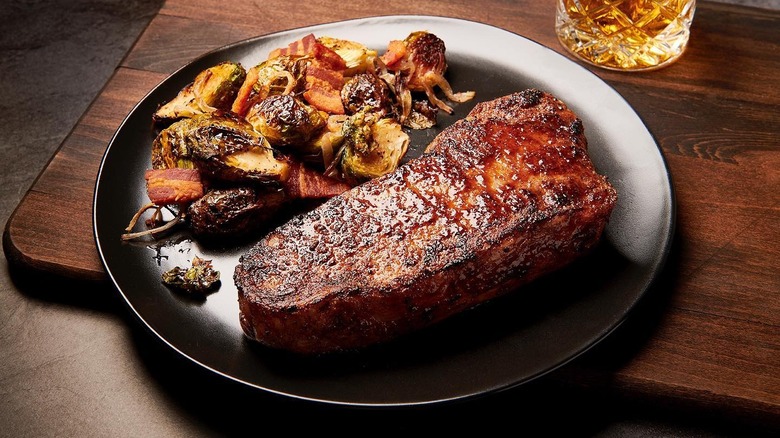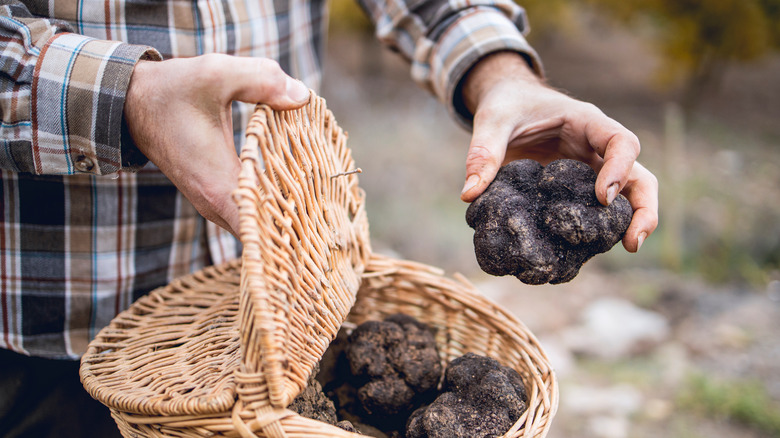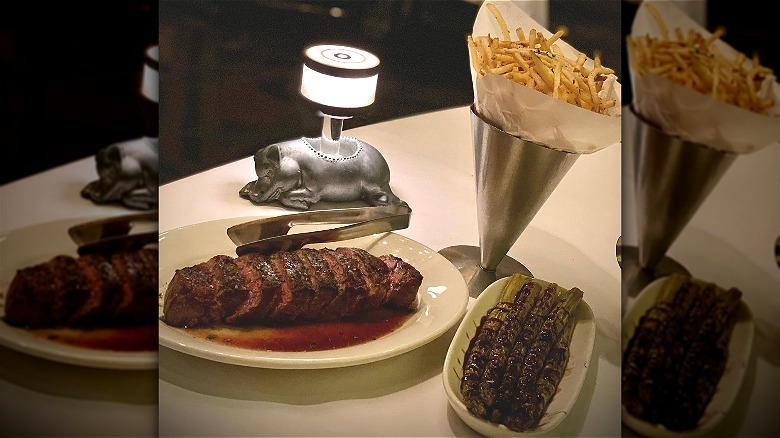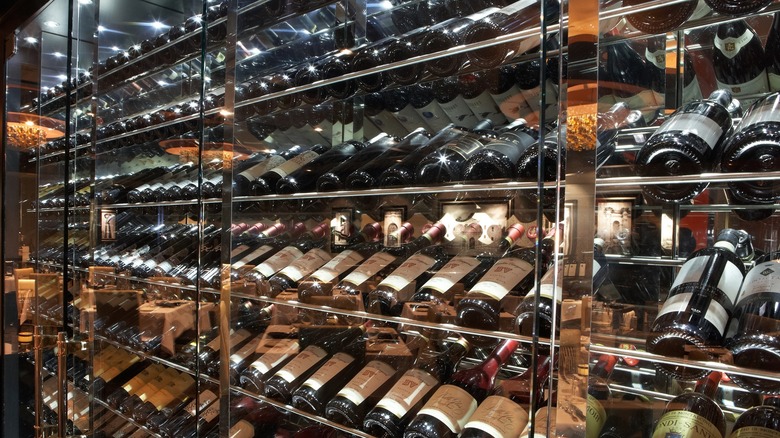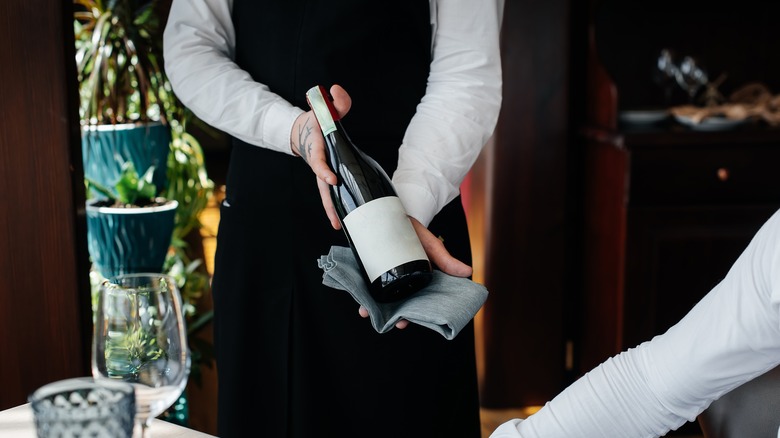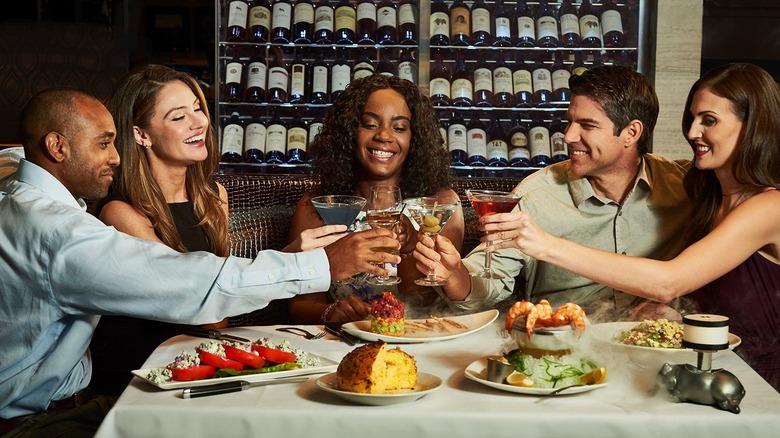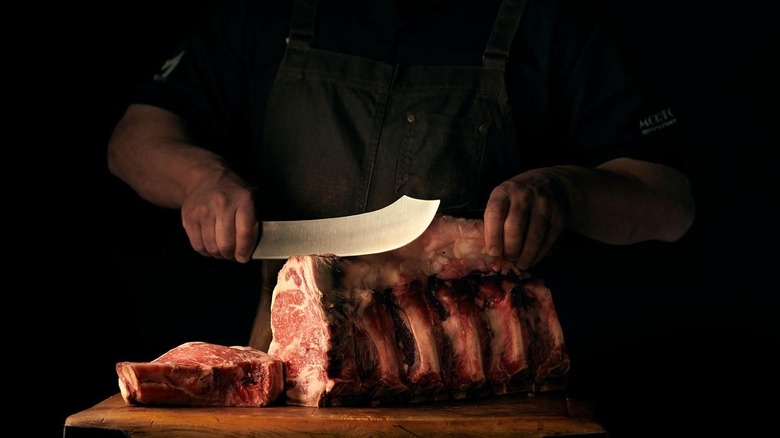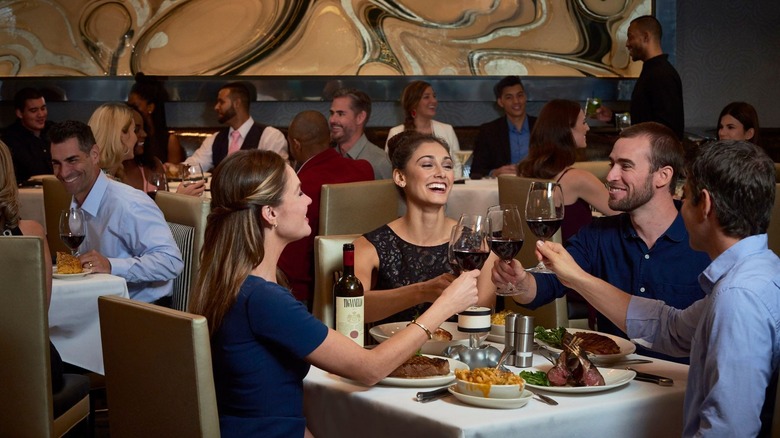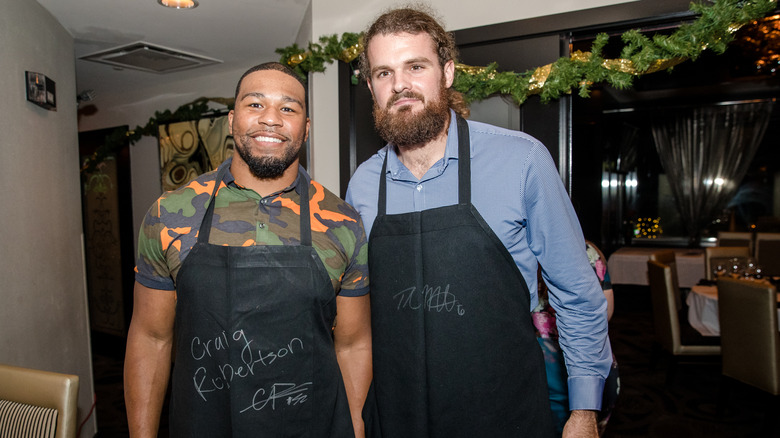The Real Reason Why Morton's Steakhouse Is So Expensive
The story of Morton's Steakhouse (or as it calls itself, Morton's The Steakhouse), ironically enough, began with a hamburger so legendary it stopped Arnold J. Morton in his tracks. He was so impressed by grill-master Karl Fritsch's burger-cooking skills that he decided to open a restaurant with him. The pair would open the franchise's first location in 1978 in the heart of Downtown Chicago. Now the company operates dozens of restaurants (per Morton's The Steakhouse).
Like any chophouse primed for success, Morton's The Steakhouse offers the kind of fare tailored to upscale tastes — think steak, seafood, and a novel-length wine and spirits list. And while that makes it a great spot for business lunches, it's not exactly realistic for everyday dining. A full steak dinner for two is expensive, and guests can easily spend a few Benjamins depending on their order. Steakhouses specialize in swank and spectacle by design, so a longtime player like Morton's isn't going to suddenly change that.
We know it's shocking to see a charred slab of cow for $60 or a $100 bottle of wine on the menu, but Morton's Steakhouse is able to do so, as we discovered, for a number of reasons. High-quality ingredients, a skilled workforce, and the nature of the fine dining industry itself allow Morton's The Steakhouse to deliver a premium experience, and that experience justifies the high price. Keep reading to find out why Morton's Steakhouse is so expensive.
The beef is USDA Prime
No restaurant showcases beef quite like an all-American steakhouse, and Morton's in particular promises that only the juiciest, highest-quality chops are accepted into its restaurants, many of which are certified Prime. Prime is the highest level of quality assessed by the United States Department of Agriculture. According to the USDA, Prime cuts are typically sourced from younger cows, and tell-tale signs include tender meat laced with distinctive ribbons of fat. This is called marbling, and you'll find less of it in cheap steak.
As Windy City Guide writes, Prime beef constitutes a slim percentage of the meat market at just 2%, making it rare for the average consumer to get their hands on it. This scarcity means that dining establishments, and upscale ones at that, will be where to go to find it, which means you have to pay high prices to get it. Since Prime meat is judged using a rigorous set of standards, restaurants can get away with charging more because it beats supermarket meat in just about every way — in flavor, texture, and appearance.
As any trip to the supermarket demonstrates, not all steaks are created equal. Steak is the focal point of a steakhouse dinner, so it needs to be able to stand on its own. A gristly, tough slab that resists cutting with silverware would not be a good look for any chophouse, and Morton's The Steakhouse prevents this by only buying the best.
Some of the steaks are dry-aged
The majority of steaks at Morton's The Steakhouse are wet-aged in the refrigerator prior to serving, according to Windy City Guide. All it takes is about three weeks of steeping in its own juices to develop a smooth, melt-in-your-mouth texture. This is already a long time to wait to cook a steak, but dry-aged cuts like the bone-in Kansas City strip take even longer, and cost more too.
Dry-aging, as Webstaurant Store explains, is when meat is fermented over a period of weeks or months in a climate-controlled environment. Oxygen in the air allows the enzymes in the beef to flourish, attacking the meat's tissues in a feeding frenzy and imbuing it with a rich, complex flavor. Compared to wet-aging, dry-aging is a notoriously lengthy process. Additionally, the amount of meat that's left at the end is quite small in comparison. Not only does the beef shrink from moisture loss, but butchers end up carving off a lot of the exterior because it develops into a hard coating known as a pellicle.
Keep in mind that this level of energy is expended on a single steak. And with all the steaks Morton's grills on a regular basis, it has to make this effort worthwhile, especially when that time and labor adds up in the long run. Savoring a dry-aged steak is a privilege, and for customers to experience this privilege they'll have to fork over the dough, and a lot of it.
Morton's The Steakhouse utilizes pricey ingredients
We've previously established why the main attraction at Morton's The Steakhouse — the steak — is expensive, so what about the rest of the menu? Predictably, many of the other dishes also contain some pricey ingredients, and we're not just talking artisanal cheeses. There's black truffle butter, which patrons can order from the Upgrades section, and the Million Dollar Burger, a limited-run sandwich Morton's launched in 2016 that was topped with foie gras (via Patch).
Of course, foie gras and black truffles don't just sound luxurious — they are expensive for a reason. Delicacies are defined by their scarcity, and black truffles and foie gras are hard to come by. In the case of black truffles, they can only survive in specific climates and have to grow for up to 7 years before harvesters are able to collect them, according to Martha Stewart. Similarly, foie gras' specialized (and fairly controversial) production technique makes it quite expensive (via Insider).
Foie gras can cost anywhere between $40 to $80 per pound, according to Gourmet Food Store, and black truffle will run you $300 a pound at the bare minimum (via Martha Stewart). Even if they're used as a garnish, that still costs a lot of money compared to more humble condiments like garlic butter or steak sauce.
Big portion sizes add up
One reason you might spend more at Morton's The Steakhouse versus other sit-down joints? It never skimps on portion size, which is surprising given its ritzy, upper-crust reputation. As shown by the menu, many of the steaks weigh close to a pound, and that's before ordering a side of matchstick parmesan & truffle fries to fill out the meal. The pork chop, New York strip, and ribeye steaks all weigh 16 ounces, and the Prime Porterhouse Steak is the largest cut of all at 24 ounces.
Morton's slogan is "The Best Steak Anywhere," and we'd argue the large servings of charbroiled beef probably contribute to that. It isn't simply good marketing on the restaurant's end, either. Real people who've dined at their local Morton's have commented on the humungous platters of food they've received, and the feedback is almost always positive. "Great steaks — HUGE PORTIONS" one Tripadvisor reviewer wrote. Another customer recommended that visitors err on the side of caution with the side dishes. "Side portions are huge, so don't order more than two if you're a couple" (via Foursquare).
When you think of the typical restaurant chain, spending almost $30 on lobster macaroni & cheese might seem like a rip-off. But the bigger portion sizes at Morton's explain the high price tag. Leaving full and happy from a steak dinner is one promise Morton's keeps, even if your wallet feels lighter afterward.
The wine list is extensive
If you thought Morton's Steakhouse's standard menu was overwhelming, just wait until you check out the wine list. The restaurant takes its vino seriously, offering at least 150 varieties at every location, The Coast News writes, and those are just the core menu offerings consistently found at all restaurants. A post by Eat Drink Journey reveals that space is reserved for locally-sourced bottles too, which means guests could sip from among 300 to 500 offerings at a time.
What's more, Morton's selection is also global in scope. American wines mingle with imports from France, Argentina, and Italy. Maintaining such an extensive wine cellar must cost an arm and a leg, and Morton's relies on money from wine sales to remain profitable. That explains why paying $10 for a glass of merlot or triple digits for a single bottle of wine is typical at the chain. If you understand that the wine list is not only exhaustive, but also high-quality, you won't get sticker shock upon receiving the check.
Morton's also offers expensive wine selections by the glass. Vice President of Wines and Spirits Tylor Field noted that some customers were more willing to pay for a single glass of high-quality wine than a whole bottle, which can boast a hefty price tag (per Nation's Restaurant News). The restaurant uses a device called a Coravin to help make sure partially-finished bottles of wine don't spoil while they're waiting to be sold.
Expert sommeliers don't come cheap
Naturally, it takes an expert's touch to make a selection from a wine list the size of a phone book, which is where the sommelier steps in. These vino connoisseurs are trained in understanding wine drop by drop and can make a suggestion based on factors like tannins, region, and the meat you'll be sipping it with. Diners can usually find one of these experts on the premises to assist with their beverage decisions (via Morton's The Steakhouse).
The sommelier profession has four rankings — Level 1, Certified, Advanced, and Master — and Morton's hires Certified Sommeliers, who fall right in the middle at Level 2. What defines a Certified Sommelier, according to Binwise, is typically 3 to 7 years of overall experience and an annual salary ranging from $60,000 to $70,000 a year. Though it's not the highest level of expertise, becoming certified can actually be fairly competitive. Only 66% of aspiring sommeliers even pass the exam.
Because it's such a specialized field, hiring professionals with that kind of education and mastery comes at a price. Level 2 sommeliers are compensated quite well, to the point that their annual income potentially tops the wages brought in by the other staff at Morton's, as Indeed shows. Nevertheless, the sommelier plays an important role in the steakhouse experience by using their expertise to increase customer satisfaction.
Morton's The Steakhouse takes pride in its customer service
According to Chief Operating Officer Tim Whitlock, customer service is the ultimate goal at Morton's, namely "great service, great upscale food, paying attention to the flavors and the plate presentation" (per Nation's Restaurant News). The steakhouse has invested heavily into the dine-in experience to keep visitors happy, and more importantly, returning again and again, but that has come at a hefty cost.
Part of the strategy has involved upgrading restaurants from every angle of the experience, as Nation's Restaurant News explains, including modernizing the interiors and overhauling the menu with trendier dishes. On the employee end, there are updated training materials and in-house training sessions conducted by restaurant personnel, who visit locations to ensure work standards are consistent and always up to snuff on expectations.
Morton's The Steakhouse doesn't simply coast on one-time orientations for staff, nor does it allow its menu to stagnate. It's constantly reinventing itself as a dining destination where sizzling steaks and poised staff never fail to charm. In 2019, Newsweek gave Morton's The Steakhouse a 9.02 out of 10 for its customer service (second behind Chick-Fil-A). Morton's topped Nation's Restaurant News' 2016 Consumer Picks Survey for white tablecloth establishments, so from a customer perspective, it seems the steakhouse has done a good job of justifying its higher price point. The reason? Its hospitality chops are basically second-to-none in the industry, and these days, that has to count for something.
The employees are highly trained
At a restaurant such as Morton's The Steakhouse demands its employees be highly trained, and by all accounts, they live up to those standards. In addition to hiring talented individuals in all sections of the restaurant, Morton's offers opportunities for job growth. A look at its career page shows certain positions qualify for advancement, and employees are promised supplemental training and support for easing into their new roles. Line cooks, for example, can work their way up the ladder to sous chef, while servers can become server trainers or captains if they complete at least eight weeks of training before pivoting to their upgraded titles.
Servers and chefs aren't the only people allowed to beef up their skill sets on the job. Leadership-level staff get to attend Morton's University in Chicago, a week-long educational seminar that instructs supervisors on the ins and outs of restaurant management. Among the topics featured in the six-day program? Effective hiring strategies, improving customer satisfaction, and improving workplace morale.
It's one thing to hold brief orientation sessions for new hires just getting started, but flying people out to Chicago for the purpose of sharpening their managerial chops? Those perks are far from typical, even for a fine dining establishment. Employees are constantly honing their talents, which means a higher probability of retaining them for the long haul. Training can certainly become expensive, but it helps Morton's stay at the top of the steakhouse game.
Morton's The Steakhouse targets a wealthy clientele
When gathering at a steakhouse, it doesn't hurt to have a lot of money on you. Part of why Morton's The Steakhouse is so expensive is because it's targeted at a wealthy clientele who can afford to splurge on the finer things in life. Workers in the business or finance sector are some of Morton's core customers. Morton's Steakhouses tend to be located in major American cities such as New York, Dallas, and Chicago, within a stone's throw of high-traffic hotspots like airports and hotels. In other words, the stomping grounds of well-traveled, high-powered tycoons.
One location in Jacksonville, Florida, the Florida Times-Union writes, apparently credited a majority of its total revenue to expense accounts in 2017. The layouts of the restaurants are set up to make them great locations for business meetings. A significant percentage of locations are equipped with private board rooms with the capacity to host large groups of people, per the Metro Detroit Chevy Dealers, along with the option of personalizing the menu. It's exactly the sort of venue tailor-made for client lunches where a handshake at the end is the only acceptable outcome.
Essentially, the philosophy is simple: People with a lot of money won't hesitate to spend it in the right circumstances. For those with the means, the luxurious ambiance of a fancy restaurant matters just as much, if not more so, than the food and service.
Celebrity benefits raise money for charity
Like most restaurants, Morton's The Steakhouse has hosted fundraising events for charity. The Celebrity Server series is a novel, swanky approach to philanthropy that allows guests to savor a steak dinner that's hand-delivered to them by celebrities, and in Morton's case, it's typically famous athletes on major sports teams who do the serving.
You can probably imagine that attending one of these star-studded soirees isn't cheap. The typical price range of the Celebrity Server series is around $300 to $400 a head, which is practically double what a regular meal at the steakhouse would cost you, considering the average check runs around $170 (via Eat Drink Journey).That's a costly sum on its own for just one person, let alone a whole crowd. But the entire point of the endeavor is to assist non-profits, not necessarily to garner profits for the business. And seeing living, breathing celebrities? It's the cherry on top.
In 2011, Main Line Today reported on an event at a King of Prussia, Pennsylvania location emceed by pro golfer Jim Furyk to raise money for Children's Miracles Network Hospitals. Later that year, Jonathan Vilma of the New Orleans Saints joined his teammates at a Louisiana Morton's Steakhouse to help in the aftermath of the 2010 Haiti earthquake. And because these events are so ritzy, it doesn't take many guests to make a killing. Per the New Orleans Saints, the team's first fundraiser with the steakhouse netted $190,000 in total donations.
